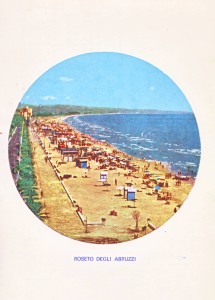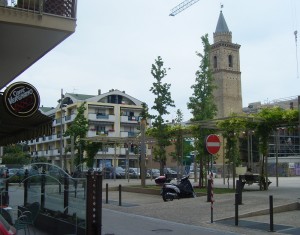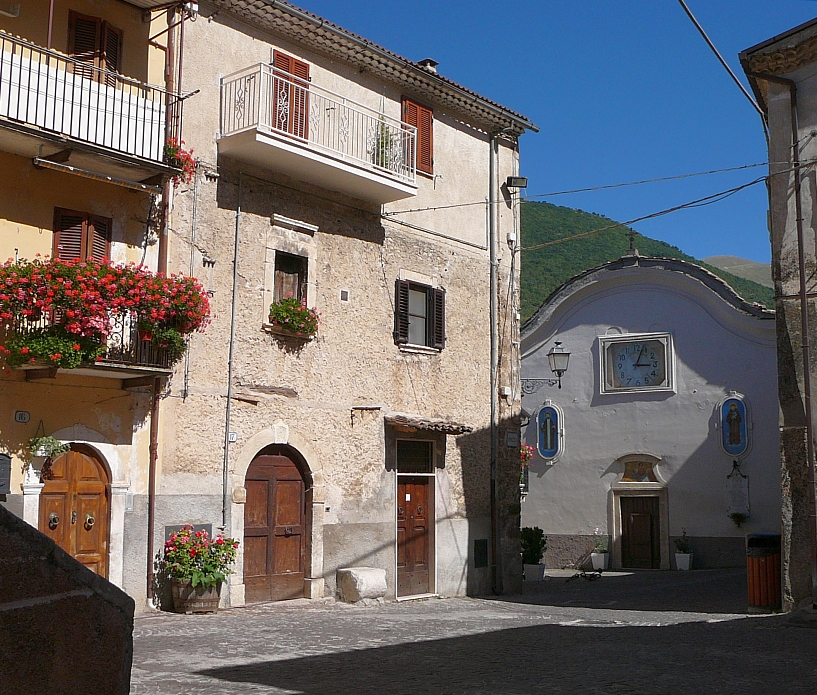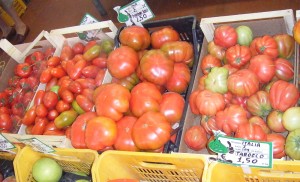Roseto degli Abruzzi, Ada’s home town, has changed beyond recognition over the last 50 years: from a small village with an economy based upon fishing and the provision of various services to the inland villages, to a holiday resort and bustling little town.
Communications were always easier along the coast, and the main road, the railway and the autostrada (highway) all now follow this north-south route, seemingly rather contemptuous of the multitude of villages and hamlets sprinkled over the valleys and mountains away from the coast.
Whereas once the beach was empty most of the year, except for the small open lateen rigged fishing boats and a limited number of privileged tourists during the peak of summer, it is now overpopulated during the summer months with hundreds of people, with all their attendant needs for lines of sun umbrellas, tables and chairs – all neatly arranged on a precise grid, each lido in its own regimental colours, ranks set facing the sea, with a bar providing the necessary flow of pizza, beers, and aperitivi or bitters. Miraculously, this all disappears at the end of the summer season, and all the paraphernalia of summer daily life on this Adriatic beach vanish into its winter quarters within a few days in mid-September. The paradox of such order and precision in the beach arrangements in Italy – a country usually associated with a more relaxed, less well regulated and spontaneous way of life – might seem perplexing to some.
The changes in the economy have been reflected in the buildings and squares of the town itself. Although marble, stainless steel and plate glass dominate its commercial buildings and shops today, there are still remnants of a previous, more traditional and less egalitarian age. When very few people could afford a holiday, the advantages of a seaside escape to Roseto were confined to the aristocracy from the urban areas of Bologna and Roma. They built villas in the “primo novecento” style, mostly from a yellowish brick under heavy clay tile roofs, in classical elegant proportions. Some of these buildings still remain, although many are in poor repair, seemingly abandoned to gradual decay, surrounded for the most part by neat but characterless apartment buildings.
Within the town centre, a long strip of modern shops runs parallel to the railway line, some clearly a modern facade on an older building, which shows its origins in more rustic times through the details of its brickwork, where arches above now bricked up windows and doorways can be seen. The town is still centred upon the square in front of the station, where the pace of life is reflected in the three bars, each with their regular patrons – most of them men – all engaged in self-important discussion, punctuating their conversation with emphatic gestures, whilst the town policemen idle away their time in the centre of the square, dressed in immaculate uniforms, accompanied by an intimidating arrangement of belts and leather work to support the large gun each one carries.
Even now, nestling among the boutiques with the latest United Colours of Benetton and especially in the back streets, are the traditional pasticcerie and pasta shops. This is where many locals come to buy the pasta all’uovo needed for some of the dishes in this section of this cooking book: the ravioli with ricotta cheese, the maccheroni alla chitarra, the agnolotti, and so on. People leave the shops with neat little trays of pasta, looking for all the world like a gift-wrapped present from Saks on 5th Avenue, New York. But the packages are prepared with infinitely more care, such is the reverence paid to pasta in Roseto.
One tradition still strong in Abruzzo is the annual preservation of tomatoes at the end of the harvest season, and we witnessed this bottling process just beginning in Castrovalva.
Near Cocullo, on a road that twists its way through the narrow passes and tunnels towards the Serra di Bocca Chiarano, by way of Scanno, there is a small side road making its way up to the village of Castrovalva. The village itself seems to have grown from the solid rock on the crest of the hill, the sheer rock rising to become the outer walls of the buildings. The road looks like a thin silver bracelet dropped from the sky, left just where it fell, and on the day we were there, it glistened in a few, rare rays of evening sun, on an otherwise overcast, wet and windswept day. One final turn and we were at the threshold of a short and finely engineered tunnel, straight through the hill, and out on the other side. Wide enough for one vehicle, this is the only access to the village, the cars having to squeeze through this passage. But this is not a problem: traffic is minimal here.
The village itself is a bewildering labyrinth of narrow streets, steeply climbing this way and that, through arches and up stairs, every building fitted into the available space, no two the same. On the day of our visit the streets were deserted, with just a wisp of smoke from some chimneys intimating a cosy refuge from the wind and rain driving across the mountain tops of the surrounding Appennino Abruzzese.
We turned one corner, and caught the sound of a bar: a low rumbling of village gossip, chairs scraping over flagstone floors, and glasses and bottles being placed heavily on wooden tables. That could only be an early evening gathering of the menfolk of the village – we heard no women’s voices – or maybe the aftermath of a late lunch. It seemed unlikely that anyone could be working, there: what would they do, and why would they be doing it there in that remote eyrie.
We met an old man, head bent into the wind and lashing rain, who did not seem too surprised to meet strangers on such a day, and in such weather. He greeted us, and pointed us the direction to the best view, which was indeed fine, since we seemed to be at the height of the surrounding peaks. There have, however, been better days on which to enjoy the view of the valleys below us, so we hurried back to the sanctuary of our car.
But there, near to the point that marks the margins of the settlement, was a large drum, with a low fire underneath it. Late August, the end of summer, is the season for the preparation and bottling of tomatoes, and the boiling water in the drum is used to sterilise the jars of freshly picked pomodori.
Roseto is something of a metropolitan centre, compared to Castrovalva, but it is still a mixed society of visitors from the big cities and the original rural inhabitants. It is those folk with strong ties to the rural areas and countryside ways who, in late August, are seen unloading large quantities of ripe tomatoes for bottling from small pickups and their three-wheeled versions, based upon a lambretta or scooter and always in the same drab oily blue or grey, some known as “Ape” or bee. Old men lift crate after crate from the pickup, which gradually returns to its normal profile and height above the road, as the suspensions recovers. The tomatoes themselves are large, craggy, pockmarked and corrugated – but what a taste: so much better than the insipid but uniform big city alternatives found in other countries.
Tomatoes are still revered as one of the main ingredients of many sauces for pasta dishes. However, there is more to Italian pastas and sauces than usually acknowledged. In this section of our cooking book we will start by describing some of the pasta dishes that we fancy most – with well-known as well as less well-known sauces, all of them freshly prepared from scratch.


